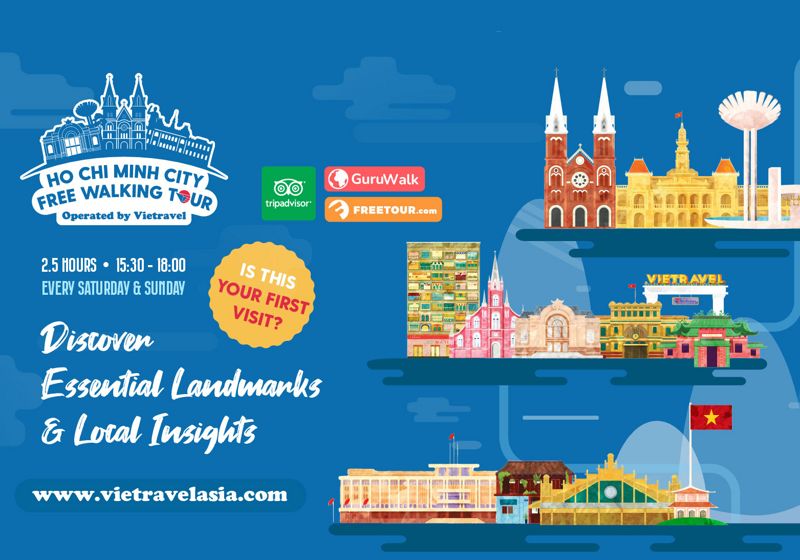
Located in the center of Ho Chi Minh City, Ngoc Hoang Pagoda, sometimes called Jade Emperor Pagoda, is a calm haven of spiritual importance. Originally constructed in 1909, this ancient temple offers tourists a window into Vietnam's rich spiritual legacy by fusing Taoist and Buddhist features. Mystique and loyalty are created by the pagoda's complex construction, vivid colors, and incense-filled ambiance. It is a must-see for anybody looking to delve into the spiritual center of the city since every angle tells a different tale, from the commanding statue of the Jade Emperor to the vivid pictures found in the Hall of Ten Hells. Let Vietravel, Vietnam's largest aviation and tourism corporation, be your guide to uncover the secrets of this significant landmark.
Learn more about Ho Chi Minh City Travel Guide.
I. Where is Ngoc Hoang Pagoda?
Located in District 1, Ngoc Hoang Pagoda occupies a central spot in the city. It's easily accessible and well-connected by various modes of transport.
- Address: 73 Mai Thi Luu Street, Da Kao Ward, District 1, Ho Chi Minh City
- Open time: 7:00 AM - 6:00 PM daily

II. The best time to visit in a day
Morning for spiritual seekers: From 7 to 9 in the morning, the pagoda conveys tranquility. Offering a true window into Vietnamese spiritual life, the incense-filled atmosphere is created by residents coming to pray. A mysterious environment ideal for thought and photography is created by the mellow morning light filtering through the elaborate building.
Tip: Arrive early to witness morning rituals and enjoy a peaceful experience before the tourist crowds arrive.
Afternoon for cultural enthusiasts: As the day progresses, the pagoda becomes livelier. The intricate details of the statues and carvings are more visible in the afternoon light. This is an ideal time to explore the various shrines and learn about Taoist beliefs and practices.
Tip: Visit between 3:00 PM and 5:00 PM to avoid the midday heat and have ample time to explore before closing.

III. The history – Ngoc Hoang Pagoda travel guide
Ngoc Hoang Pagoda was constructed at the turn of the 20th century by the Cantonese community in Ho Chi Minh City, then known as Saigon. The pagoda was built to honor the Jade Emperor, the supreme Taoist deity in Chinese mythology. This community, primarily consisting of Chinese immigrants, sought to establish a place of worship that reflected their cultural and spiritual beliefs.
The pagoda holds significant cultural importance for the local Chinese-Vietnamese community and is one of the most revered Taoist temples in the city. It serves as a focal point for religious ceremonies and festivals, where devotees come to pray for blessings such as health, prosperity, and familial harmony.
Over the years, Ngoc Hoang Pagoda has undergone several renovations and expansions to maintain its structural integrity and preserve its historical significance. Despite its age, the pagoda continues to be a vibrant center of religious and cultural activities, attracting not only worshippers but also tourists eager to explore its architectural beauty and learn about its spiritual traditions. Today, Ngoc Hoang Pagoda remains an active place of worship and a popular cultural landmark in Ho Chi Minh City. It continues to play a vital role in preserving and promoting the cultural heritage of the Chinese-Vietnamese community while welcoming visitors from all backgrounds to experience its spiritual ambiance and architectural splendor.
The pagoda gained international fame when it was visited by U.S. President Barack Obama in 2016, highlighting its cultural significance and architectural beauty.

Read more about Independence Palace Travel Guide
IV. Architectural wonders - Ngoc Hoang Pagoda Travel Guide
Reflecting the harmonious character of religious rituals among the Chinese diaspora in Vietnam, Ngoc Hoang Pagoda combines Taoist and Buddhist architectural styles. The pagoda's facade is decorated with colorful tiles, ceramic figures, and elaborate wood carvings that represent scenes from Chinese culture and mythology. In the main hall, elegant shrines where sacrifices are given during rituals are surrounded by sculptures of gods and other heavenly creatures.
1. Key architectural elements include:
- The main hall: Houses the statue of the Jade Emperor
- The Hall of the Ten Hells: Showcases graphic depictions of karmic punishments
- The turtle pond: A symbol of longevity in Vietnamese culture
- The rooftop: Adorned with elegant dragon and phoenix sculptures
2. Exterior
The pagoda is magnificently created in the Chinese religious construction style, with numerous beautiful paintings and walls. The roof is made up of yin-yang tiles that are brightly colored. On the roof and gables, there are a few statues.
The main entrance of the pagoda is approximately 6 meters wide and 4.5 meters high. It is a one-door gate with a single roof, not a three-door gate with multi-tier roofs like many other pagodas and temples in Ho Chi Minh City.
In actuality, there are two entrances: the main entrance, which is supported by two pink concrete pillars and has a tiled roof, and the smaller side entrance. Two stone doors with red Chinese inscriptions support the smaller entrance.

The pagoda is highlighted by dozens of large oak trees that provide ample shade. Despite the sweltering temperature in Ho Chi Minh City, travelers will appreciate the fresh cool air as they enter the pagoda's courtyard. It is a world away from the rest of Saigon, which is packed and bustling with many buildings and skyscrapers.
3. Interior
Inside the pagoda, there are many paintings, statues, and altars made of various materials, including wood, porcelain, and cardboard. About 300 figurines, including 100 made of cartridge paper, can be found in the pagoda.
The pagoda has 3 halls: the front hall, the middle hall, and the back hall. Each hall is a one-of-a-kind ancient architectural masterpiece. A Buddha statue can be found in the front hall. On big occasions, people sing and feast in the front and middle halls.

V. What to do at Ngoc Hoang Pagoda
1. Explore the shrines
Visit the various shrines dedicated to different deities. The main altar, dedicated to the Jade Emperor, is particularly impressive with its intricate woodcarvings and vibrant colors.
2. Observe rituals
Witness locals performing prayer rituals, offering incense, and seeking blessings. Remember to be respectful and maintain a quiet demeanor.
3. Study the artwork
Take time to admire the detailed murals and sculptures throughout the pagoda. Each piece tells a story from Taoist or Buddhist mythology.
4. Visit the turtle pond
Located in the courtyard, the turtle pond is home to several turtles. Visitors often feed the turtles as a way to gain good fortune.
5. Explore the Hall of the Ten Hells
This unique section of the pagoda depicts the judgments and punishments in the afterlife according to Taoist beliefs.
VI. Important notes for visitors
- Dress code: Wear modest clothing that covers your shoulders and knees as a sign of respect.
- Photography: While photography is generally allowed, be mindful of worshippers and avoid using flash in the main prayer areas.
- Shoes: You may be required to remove your shoes before entering certain areas of the pagoda.
- Donations: While entry is free, donations for the upkeep of the pagoda are appreciated.
VII. How to get to Ngoc Hoang Pagoda? - What to do in Ho Chi Minh City
1. By Taxi / Ride-sharing Services
The most convenient way to reach Ngoc Hoang Pagoda is by taxi or ride-sharing services such as Grab or Gojek. These services are widely available throughout Ho Chi Minh City and offer a comfortable and direct route to the pagoda. Simply enter "Ngoc Hoang Pagoda" as your destination in the app.
2. By Bus
Several bus routes pass near Ngoc Hoang Pagoda. You can take bus numbers 18, 54, or 91, which have stops within walking distance of the pagoda. Check the latest bus schedules and routes for the most accurate information.

Check the bus guide in Ho Chi Minh City.
3. By Walking
If you are staying nearby, consider walking or cycling to the pagoda. This allows you to explore the surrounding area and enjoy the vibrant street life of Ho Chi Minh City. The pagoda is centrally and easily reachable on foot.
4. By Cyclo
Want an old-school ride? Try a cyclo – it's like a big bike with a seat. It costs more, but it's a special way to see the city. You can take photos as you ride to Ngoc Hoang Pagoda.

VIII. Conclusion
Ngoc Hoang Pagoda offers a fascinating glimpse into Vietnam's spiritual heritage. Its unique blend of Taoist and Buddhist elements, coupled with its intricate architecture, makes it a must-visit destination in Ho Chi Minh City.
For an immersive experience of Ho Chi Minh City's religious sites, consider joining Vietravel's Walking Tour. Our knowledgeable guides will provide you with in-depth insights into the religious practices and architectural significance of various spiritual landmarks throughout the city.Ready to explore more of Ho Chi Minh City? Dive into our comprehensive city guide for detailed itineraries, tips, and recommendations to ensure a memorable trip. Let Vietravel help you discover the spiritual heart of Vietnam's bustling metropolis.
As the Largest Aviation - Tourism corporation in the country, Vietravel consistently provides high-standard services at the most competitive prices so that you can discover the beauty of not only Vietnam but all of Southeast Asia.
Please contact us for more information
Vietravel – Asia’s Leading Tour Operator
Hotline: (84) 35 235 61 61
Email: [email protected]
Website: www.vietravelasia.com
#VietravelAsia #Vietravel #Vietnam #Hochiminhcity #NgocHoangPagoda #discovery #attraction #travelguide #WheretogoinHoChiMinhCity? #WhattodoinHoChiMinhCity


